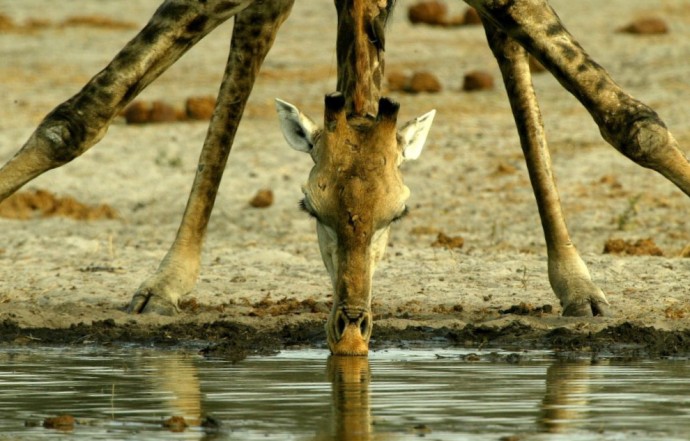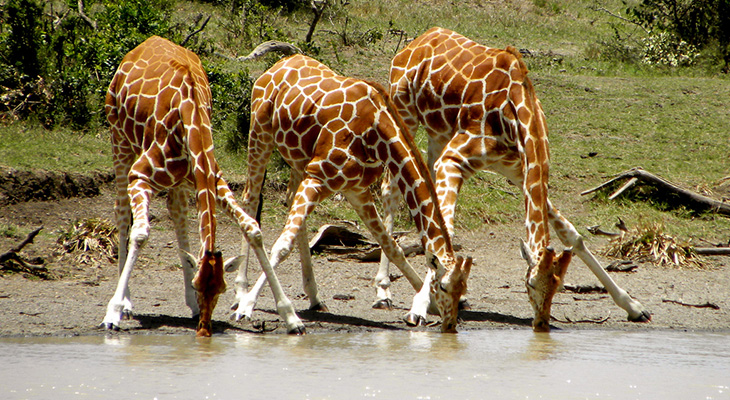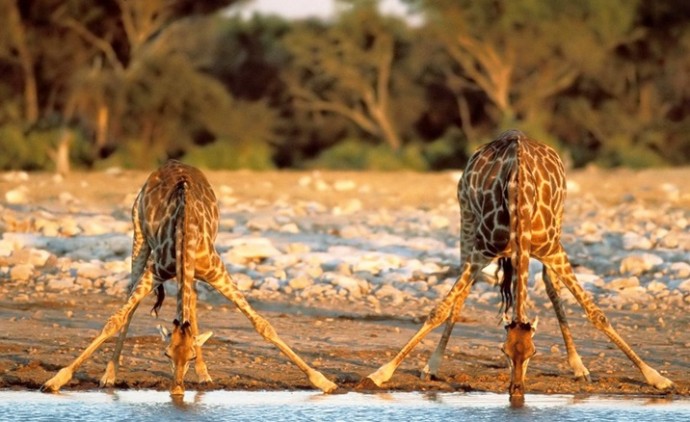Physics in the animal world: the giraffe and its "pump"

For humans, many animals seem familiar, they seem to be already and can not surprise us with anything. But in fact, any living organism on Earth is a whole biochemical laboratory that contains a number of interesting mechanisms. About many animals materials on Geektimes were already published, but, of course, far not about all.
Have you ever wondered how a giraffe drinks water? Maybe someone even saw an animal doing this in a zoo? In fact, with such a long neck, like a giraffe, just drink will not work. In his body there are several devices that allow you to quench thirst without any problems when you want. Outwardly, everything is simple - the animal spreads its forelimbs and tilts its neck, touching the surface of the water with its lips. The most interesting thing is hidden from human eyes.
A little about the neck itself
The giraffe’s neck would have complicated the animal’s life if it were not for a number of compensating mechanisms. For example, in order to raise blood to the head by a few meters, the heart of an animal increased in size, its walls became much thicker than, for example, Okapi, a close relative of the giraffe. The blood pressure of this animal is two or even three times the blood pressure of a person. This heart skips about 60 liters of blood per minute, its weight is 12 kilograms. The blood of a giraffe is thicker and has twice the density of blood cells than in humans. According to some scientists, this indicator is one of the highest among all existing animals.
')
And here there are some more problems. For example, if it were not for a number of compensating mechanisms, high blood pressure would simply kill the giraffe when it lowers its head down. A large amount of blood would be pumped into his brain. But the neck vessels have specific valves that protect the brain of the animal. A similar problem, only reversed in sign, so to speak, occurs when the giraffe lifts its head. This happens quickly, and if it were not for another group of compensating mechanisms, the pressure of the blood at that moment would drop dramatically. Perhaps this would not have killed the animal, but it would lose consciousness every time it raised its head to its original height. All unusual vessels that are able to keep the pressure of the animal at about the same level come to the rescue.
Giraffe - very big. This is the tallest animal in the world. In the process of movement, there are overloads, which in a normal situation, without adaptation of the organism under such loads, would simply slowly kill this animal. For example, in his limbs water would constantly accumulate. In order to prevent this phenomenon in case of overload in a person, special suits of special design are used. The giraffe has its own "suit" of this type, created by nature itself in the course of evolution. It has strong and elastic epithelial tissue and an unusually elastic connective tissue.
Giraffes can run fast, in case of urgent need they can gallop at a speed of 55 km / h, that is, at short distances they can overtake a racing horse. However, as a rule, these animals walk slowly, moving both right hooves at the same time, then both left hooves. Because of its large weight and thin legs, giraffes can only walk on a hard surface.

How does a giraffe drink?
But back to the water and the process of quenching thirst from these giants. For a long time it was believed that animals manage to drink water due to the fact that they create an area of low pressure in the esophagus and stomach. Thus, scientists had previously argued, water rises from the source in the throat and then flows into the esophagus and stomach. In fact, the giraffe is unable to create a low pressure area in this way.

That is, it is created, but in a different way - thanks to the synchronous actions of various elements in the neck of the animal. The epiglottis, on the one hand, and the lips of the animal, on the other, are involved in this process. Leaning towards the water, the giraffe squeezes the lips in a special way and begins to suck water, and the “valve” of the epiglottis is closed. Then the lips are closed, and the "valve" in the epiglottis opens, which allows water to move into the esophagus.
This process is repeated over and over. At some stage, the animal lifts its head and neck, and the water passes into the stomach. This is repeated several times until the giraffe gets drunk. According to the researchers, water is pumped into the animal’s body at approximately 10 km / h. This is enough so that the flow of water creates pressure at the entrance to the esophagus, so that the water already there does not flow back. Only in the esophagus can be at the same time about 5 liters of water. Each injection cycle ensures that 300 milliliters of water enter the esophagus. For 25 seconds, the giraffe can perform up to 17 such cycles.

Interestingly, all these data were obtained by physicist Philip Binder, who last year went to one of the national parks of South Africa. He watched the animals for quite a long time, at close range, so that he could, during his observation, understand exactly what was happening in the neck of the giraffe when he was drinking. One of the videos taken at the Phoenix Zoo in Arizona shows a thirst quenching process with a giraffe at close range.
In order to ensure the normal functioning of the body, nature had to increase during the evolution of the lungs of the giraffe, so that it could breathe at a height of 3 meters, pumping air into the lungs. These bones, muscles and connective tissue have changed - because, as mentioned above, the giraffe is constantly experiencing overload.
Giraffes inhabit the savannas of Africa. Today they can be found only to the south and southeast of the Sahara, primarily in the savannas of Eastern and Southern Africa. Populations north of the Sahara were eradicated by man in antiquity: in times of ancient Egypt, they existed in the Nile Delta and on the shores of the Mediterranean Sea. Unfortunately, in the XX century, the range of giraffes again significantly reduced. The largest populations of giraffes today live in reserves and reserves.
Source: https://habr.com/ru/post/399797/
All Articles